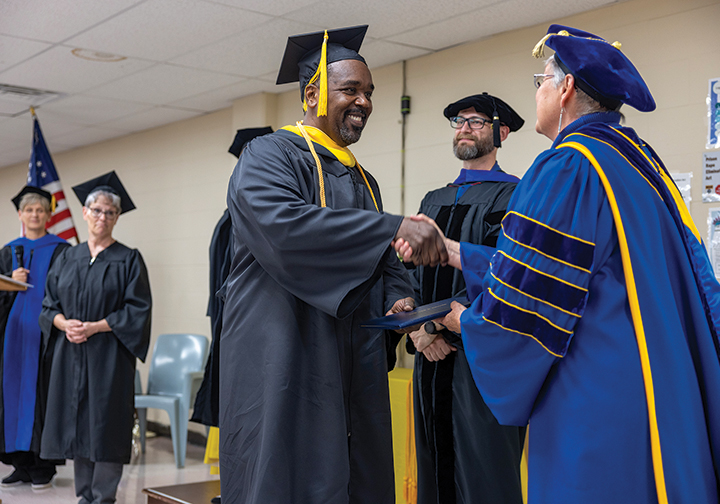
by John Shultz
Special to The Leaven
LEAVENWORTH — Three years after the University of Saint Mary here began a renewed effort to offer undergraduate degree programs at the Lansing Correctional Facility, a half dozen students there donned caps and gowns to walk a makeshift graduation stage this summer, earning their bachelor’s degrees and joining the ranks of USM alumni.
The six students — Michael Gaynor, Charles Johnson, William Mason, Sean Murphy, Danny Pickerill and Zachary Smith — all earned a bachelor’s degree in computer information science. Their accomplishments were made possible by the Second Chance Pell Experimental Sites program initiative.
USM began offering undergraduate degrees inside the correctional facility in 2021, after being selected as a participating educational institution for the Second Chance Pell program.
“We are grateful that we are able to return to providing bachelor’s degrees behind the walls,” said Sister Diane Steele, SCL, university president. “We believe in the dignity of all people’s ability to learn, and we know that education greatly reduces recidivism. Evidence shows that quality education changes lives for the better.”
For Saint Mary, it marked a return to a mission of serving the incarcerated. USM has a long history of offering postsecondary education at penal institutions. From the early 1980s to the mid-1990s, the university established programs at four correctional sites in the Leavenworth area.
Three of this summer’s grads — Mason, Pickerill and Johnson — began taking courses from Saint Mary at the Lansing Correctional Facility in the early 1990s. They stopped when their Pell Grants ended in 1994. Thirty years later, the students finished their degrees and celebrated with family at a graduation ceremony in May.
The University of Saint Mary also offers degrees at the U.S. Disciplinary Barracks and the Joint Regional Correctional Facility, both located on Fort Leavenworth. The USM Prison Education Program offers an associate degree in business administration, a bachelor’s degree in business administration-management and a bachelor’s degree in computer information science at the various locations.
USM hopes to expand this effort at additional facilities.
Equal access to education is not only for the incarcerated — although the USM Prison Education Program strives to reduce recidivism and transform the lives of incarcerated individuals and their families through postsecondary education.
It is in the best interest of the community at large as well, according to expert analysis.
Studies from the Bureau of Justice Statistics of the U.S. Department of Justice have found high rates of recidivism among released prisoners. One study, which tracked 404,638 prisoners in 30 states after their release from prison, found that about two-thirds (67.8%) of released prisoners were rearrested within three years of release and more than three-quarters (76.6%) were rearrested within five years. More than half (56.7%) of these rearrests were in the first year after release.
However, there is a 43% reduction in recidivism rates for those prisoners who participate in prison education programs. Indeed, the higher the degree, the lower the recidivism rate is: 14% for those who obtain an associate degree; 5.6% for those who obtain a bachelor’s degree; and 0% for those who obtain a master’s degree.
“USM has witnessed the impact on students firsthand from our experience educating incarcerated students,” Sister Diane said.
“We believe our participation in Second Chance Pell will improve opportunities for incarcerated people and lead to safer prisons and communities,” she added.






